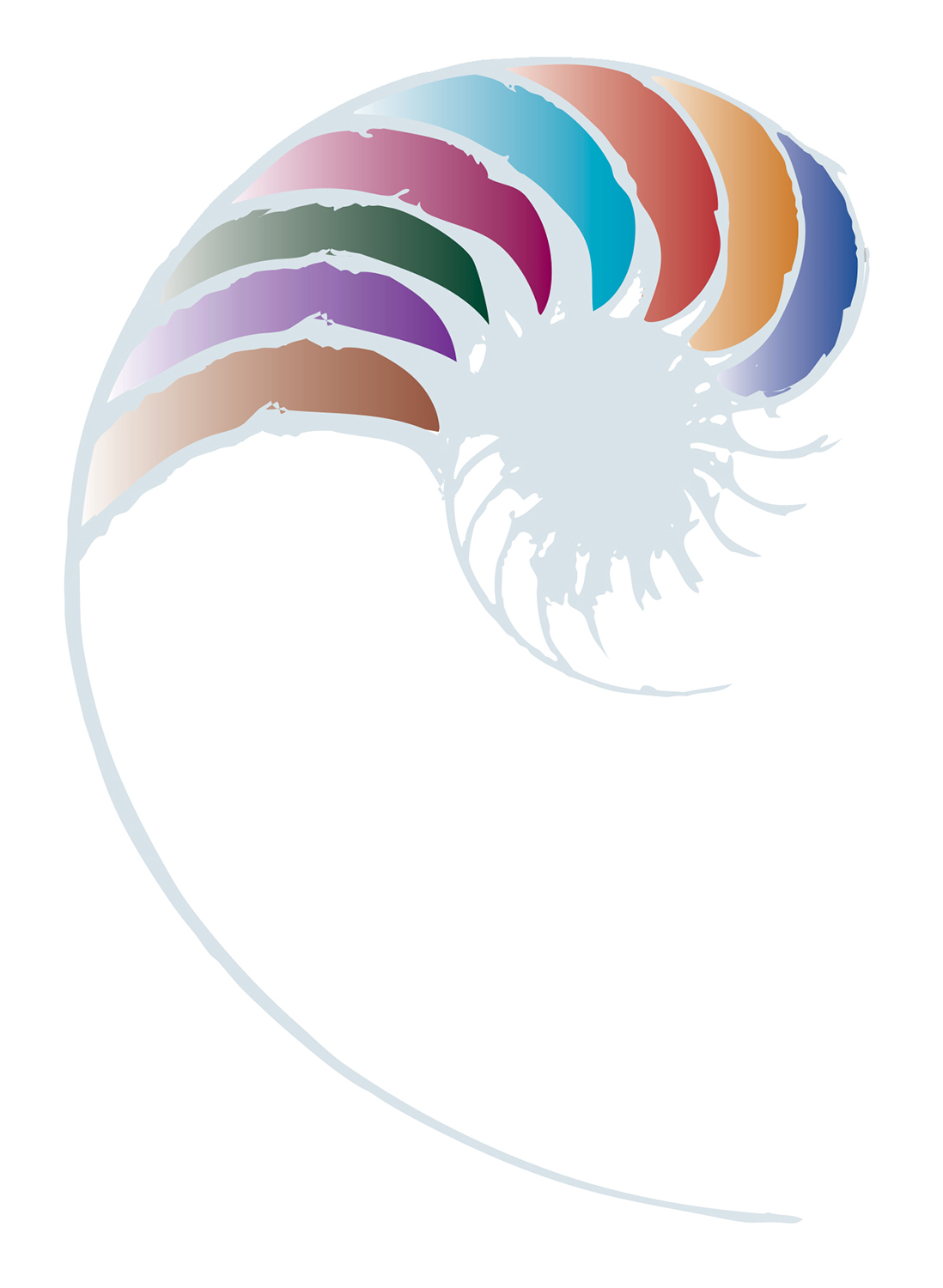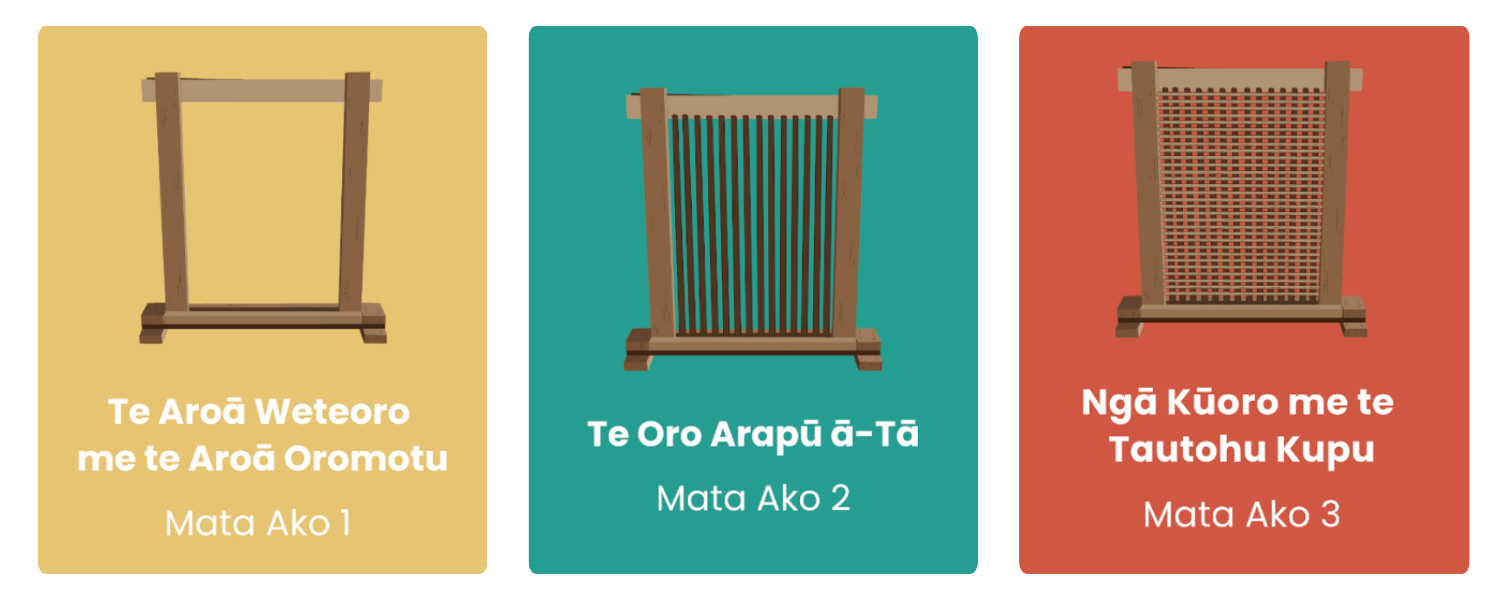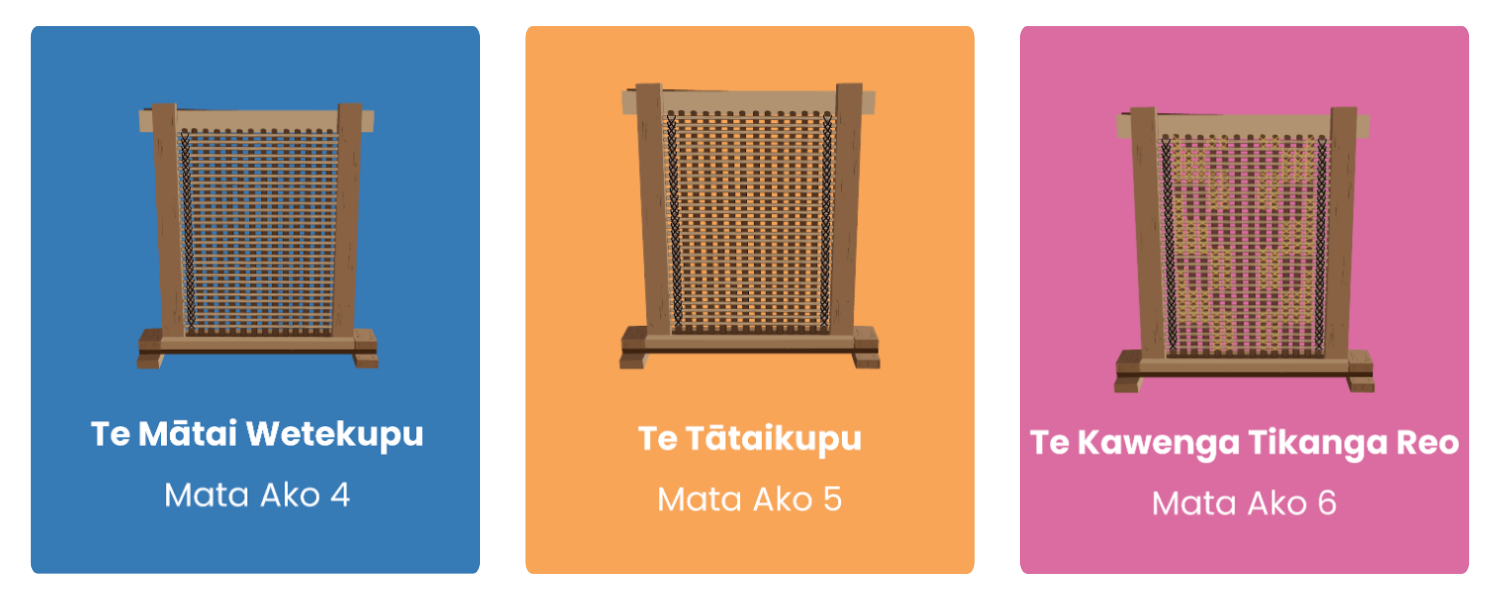
Rangaranga Reo ā-Tā - Tūārere 2
Rangaranga Reo ā-Tā
Tūārere 2
Te Reo Matatini
Ngā tini mata o te reo - the many faces and facets of language
The term te reo matatini is credited to Professor Wharehuia Milroy, Dr Huirangi Waikerepuru, and Pēti Nohotima who sought to capture the essence of what would be required to deliver a programme of learning that upheld the heart of ‘te reo Māori’ in ways that acknowledge the deep and diverse forms that it takes and the wide range of functions it performs.
Te Reo Matatini therefore, is a culturally located term and is so much more than what is suggested in our print saturated world. As articulated by the late Hirini Melbourne:
“...The ancient world of the Māori was surrounded by writing in their daily life: the carvings on posts and houses, the marks on cloaks, the very architecture of the great meeting houses…”
“...The fact that texts - compositions, speeches, ritual replies, and so forth - were memorised, not written down, does not mean that the ancient Māori inhabited a world from which writing [as we know it], was absent. It was a world in which a variety of forms, written and oral gave vivid and complex expression to a culture..”
Melbourne's view presents an authentic pathway by which mokopuna can gain access to, and create mātauranga, where they learn to articulate their understanding of the past, interact with their present and influence their future world because there are multiple contributors and multiple ways to get there.
Rangaranga Reo ā-Tā
Rangaranga = structure
ā-tā = the term in Te Marautanga o Aotearoa (2008) referencing pānui and tuhituhi
Rangaranga Reo ā-Ta is the term in te reo Māori for specific elements related to learning to read and write in te reo Māori.
The construction of a tukutuku panel, known as tuitui is used as a metaphor for Rangaranga Reo ā-Tā. Construction and design happens in a systematic and deliberate way. More often than not, the weavers already have a vision of the finished product and work together to realise that vision. A fully completed panel is called a tūrapa.
Construction typically involves two people. In the classroom setting, this represents the reciprocity of the teaching and learning process (i.e. ako) between the mokopuna and the kaiako.
You start by building a frame on legs (te aroā weteoro me te aroā oromotu | phonological and phonemic awareness). The frame forms the foundation upon which the vertical slats (te oro arapū ā-tā | alphabetic principle) and the horizontal slats (ngā kūoro me te tautohu kupu | syllables and word recognition) are placed. The vertical slats are known as tautari while the horizontal slats are known as kaho.
A left overlapping wrapped stitch (te mātai wetekupu | morphology) and a right overlapping wrapped stitch (te tātaikupu | syntax) bind the frame and the slats together giving the overall structure its stability. The stitch is known as tūmatakāhuki.
It is only then that you can start creating your pattern which embodies the meaning, the story you want to imbue into your panel (te kawenga tikanga reo | semantics).
The materials used for building the frame and tukutuku panels themselves, were typically chosen based on what was readily available in the immediate environment of the weaver. Traditional materials such as toetoe, pīngao, and kiekie were commonly used. Now, with the introduction of modern and synthetic materials, weavers have greater choice and flexibility in both the construction of the frame and creation of the tukutuku pattern itself.
The tukutuku panel which here symbolises Rangaranga Reo ā-Tā, typically adorns the walls of the wharenui. The wharenui, if we are to continue the metaphor, represents te reo matatini - as signaled in Hirini Melbourne’s description.
While Rangaranga Reo ā-Tā involves the explicit, systematic, and cumulative teaching of pānui and tuhituhi, the reo matatini within which Rangaranga Reo ā-Tā sits must also explicitly attend to the development of oral language proficiency because the relationship between pānui, tuhituhi and kōrero is one of interdependence.
Rangaranga Reo ā-Tā considers:
ngā hua whakaako (scope) - what needs to be taught.
te raupapa whakaako (sequence) - the order in which the elements of Rangaranga Reo ā-Tā need to be taught.
te wā whakaako (pace) - appropriate timing for teaching the elements of Rangaranga Reo ā-Tā, guided by broader evidence from mokopuna learning and engagement that indicates readiness to effectively engage with these elements.
Ngā Mata Ako Rangaranga Reo ā-Tā:
phonological and phonemic awareness
|
|
|
alphabetic principle |
syllables and word recognition |
|
morphology
|
|
syntax |
|
|
semantics |
Kaiako should explicitly plan to integrate the language strands, whakarongo, kōrero, pānui, tuhituhi, mātakitaki and whakaatu. |
Language competency is critical for mokopuna to successfully access the curriculum and learning that is relevant to their world. |
It is important to make connections across the curriculum between prior knowledge and new knowledge by providing a range of stimulating and engaging experiences. |
- Te Reo Rangatira
- Kōrero
- Pānui
- Tuhituhi
- Rangaranga Reo ā-Tā
- Rauemi
- Tuhi ā-Ringa
|
||||||
Kia Tika |
Kia Mārama |
Kia Arero Taiaha |
Kia Auaha |
|||
Toi Mokopuna |
||||||
He kaingākaunui te mokopuna ki te tika o te reo. |
He whakaaro arohaehae te mokopuna. |
He whai whakaaro te mokopuna ki te āhua o tana whakapuaki i ōna whakaaro. |
He whai hua, he auaha, he Māori te whakamahi a te mokopuna i te reo. |
|||
Tohu Ako: Tūārere 2: Tau 4–6 |
||||||
Whāinga |
||||||
Ka aro te ako a te mokopuna |
Ka aro te ako a te mokopuna |
Ka aro te ako a te mokopuna |
Ka aro te ako a te mokopuna |
|||
|
||||||
Kia Tika |
Kia Mārama |
Kia Arero Taiaha |
Kia Auaha |
|||
Toi Mokopuna |
||||||
He kaingākaunui te mokopuna ki te tika o te reo. |
He whakaaro arohaehae te mokopuna. |
He whai whakaaro te mokopuna ki te āhua o tana whakapuaki i ōna whakaaro. |
He whai hua, he auaha, he Māori te whakamahi a te mokopuna i te reo. |
|||
Tohu Ako: Tūārere 2: Tau 4–6 |
||||||
Kia Mataara |
||||||
Hei te mutunga o te tau 4, |
Hei te mutunga o te tau 4, |
|
|
|||
|
Hei te mutunga o te tau 5, |
|
|
|||
Ngā Whakaakoranga

Ngā Whakaakoranga
- I te tau tuawhā
- I te tau tuarima
- I te tau tuaono
Whenu: Wetewetehia kia tika
Mokopuna care about saying things correctly.
Te Whāinga
Mokopuna learning focuses on accurately understanding and using a range of vocabulary and sentence structures.
Te ngako o te whāinga
During a lesson, support the mokopuna to:
Expand their vocabulary to include less common words.
Use increasingly more complex language to convey messages clearly.
Use some subject specific language.
Understand how language is used in everyday interactions and adapt to the audience.
Whenu: Ākona kia mārama
Mokopuna are critical thinkers.
Te Whāinga
Mokopuna learning focuses on interpreting a range of oral, written, and visual texts.
Te ngako o te whāinga
During a lesson, support mokopuna to:
Listen to native speakers and imitate their language.
Listen for key information.
Formulate and respond to more complex questions.
Participate in group discussions to develop opinions and reflections.
Whenu: Whāia kia arero taiaha
Mokopuna are thoughtful about how they express their ideas.
Te Whāinga
Mokopuna learning focuses on using basic interpersonal communication skills effectively.
Te ngako o te whāinga
During a lesson, support mokopuna to:
Develop their interaction skills encouraging them to:
share simple ideas, opinions, or responses during group and class discussions.
listen attentively and ask simple clarifying questions.
practise acknowledging what they have heard.
pause before responding to allow for thoughtful answers.
reflect on what they have heard, seen, felt, read, or written.
Adapt their communication style to suit when in discussions with peers and adults.
Understand that people from different regions have different words and ways.
Whenu: Tāraia kia auaha
Mokopuna use language effectively, creatively, and in a Māori way.
Te Whāinga
Mokopuna learning focuses on using descriptive and figurative language.
Te ngako o te whāinga
During a lesson, support mokopuna to:
Craft stories by organising their thoughts in a coherent sequence including:
brainstorming.
coming up with new ideas (think again).
grouping similar ideas.
prioritising ideas.
reflecting on how well they conveyed their message.
asking "what if" questions.
using mnemonics and rhythm to learn new words and concepts.
Describe how things look, feel, taste and sound with detail.
Explore creative ways to present their experiences.
Think about appropriate body language when presenting.
Incorporate basic examples of figurative language such as idioms, onomatopoeia and alliteration.
- I te tau tuawhā
- I te tau tuarima
- I te tau tuaono
Whenu: Wetewetehia kia tika
Mokopuna care about saying things correctly
Te Whāinga
Mokopuna learning focuses on accurately understanding and using a range of vocabulary and language structures.
Te ngako o te whāinga
During a pānui lesson, support mokopuna to:
Use their ability to decode with their knowledge of how the Māori language works to read more accurately while checking that what they have read makes sense.
Read with appropriate rhythm, intonation, and phrasing to convey meaning and reflect the structure of the text.
Identify and describe basic elements in a visual text, for example use of colour, shape, layout, text, font style.
Understand features and conventions of written language.
Knowledge of Concepts About Print
Demonstrates one-to-one correspondence between the written word and the spoken word
Demonstrates knowledge of the macron, its function and rules governing its use
Explains the function of commas, question marks, exclamation marks, quotation marks, ellipses
Identifies and discusses features used to emphasise words (highlighting, italicising, capitalising, bolding)
Demonstrates while reading and writing the impact of punctuation and emphasised words and phrases on meaning, expression and fluency
Whenu: Ākona kia mārama
Mokopuna are criticial thinkers.
Te Whāinga
Mokopuna learning focuses on interpreting a range of oral, written and visual texts.
Te ngako o te whāinga
During a pānui lesson, support mokopuna to:
Engage with a variety of word-based and visual texts and text purposes
Recognise and describe the main images or illustrations in a visual text and talk about how they relate to the overall message or story.
Use a range of strategies to derive meaning from new words and sentence structures and unfamiliar contexts.
Ngā Rautaki
Predicting
- Make predictions about the text using:
- the front cover of the book
picture cues
characters’ roles
Make predictions about what will happen next while reading.
Monitoring
Attempts to self-correct when meaning breaks down
Considers if errors or attempts at word(s) make sense in the context of the story
Considers if errors or attempts at word(s) are correct language structure for the Māori language
Considers if errors or attempts at words look like the word(s) in the text
Is integrating some or all of the cues and may self-correct as a result
Scanning
Scans over a text to locate key information in order to answer a specific question
Scans a text to locate a keyword or words
Skimming
Skims a text by reading it quickly to get the gist of it
Inferring
Uses illustrations to identify how a character is feeling
Relates what is happening in the text to their own knowledge and experiences to provide explanations or draw conclusions about events or information in a text
Uses the clues in a text that describe character behaviour to identify characters’ personalities and feelings
Evaluating
Describes what they like or do not like about the text
Makes a judgement about the ideas presented in the text based on personal experiences
Decides what information is fact or fiction
Imaging
Makes mental images in their head about significant events and characters while reading a text
Creates a portrait of a character using the author’s description of that character
Describes how they feel about what happens to a character in a text
Sees, hears and feels certain things that are described in the text
Identifies and discusses descriptive words and phrases in a text
Main Ideas and Synthesising
Links the main idea of the text to their own personal experiences
Recognises main ideas and supporting details
Reflects on and discusses the theme or moral of the story
Synthesises and summarises the main ideas
Locates the same or similar information from different sources
Kia Mataara |
By the end of year 4, mokopuna should have a selection of strategies to derive meaning from new words when reading. |
Whenu: Whāia kia arero taiaha
Mokopuna are thoughtful about how they express their ideas.
Te Whāinga
Mokopuna learning focuses on using basic interpersonal communication skills effectively.
Te ngako o te whāinga
During a pānui lesson, support mokopuna to:
Develop their interaction skills encouraging them to:
share simple ideas, opinions, or responses during group and class discussions.
listen attentively and ask simple clarifying questions.
practise acknowledging what they have heard.
pause before responding to allow for thoughtful answers.
reflect on what they have heard, seen, felt, read, or written.
Express how a visual text makes them feel and suggest reasons why.
Whenu: Tāraia kia auaha
Mokopuna use language effectively, creatively and in a Māori way.
Te Whāinga
Mokopuna learning focuses on using descriptive and figurative language.
Te ngako o te whāinga
During a pānui lesson, support mokopuna to:
Broaden their bank of familiar words by engaging with new vocabulary.
Identify basic examples of figurative language such as idioms, onomatopoeia and alliteration.
- I te tau tuawhā
- I te tau tuarima
- I te tau tuaono
Whenu: Wetewetehia kia tika
Mokopuna care about saying things correctly.
Te Whāinga
Mokopuna learning focuses on accurately understanding and using a range of vocabulary and sentence structures.
Te ngako o te whāinga
During a tuhituhi lesson, support mokopuna to:
Spell words accurately.
Expand their vocabulary to include less common words.
Write longer sentences.
Understand features and conventions of written language.
Kia Mataara |
By the end of year 4, mokopuna should be making near-correct attempts at using words with multiple syllables in their writing. |
Whenu: Ākona kia mārama
Mokopuna are criticial thinkers.
Te Whāinga
Mokopuna learning focuses on interpreting a range of oral, written and visual texts.
Te ngako o te whāinga
During a tuhituhi lesson, support mokopuna to:
Produce a greater variety of texts to meet a range of text purposes.
Use a variety of sentence types when writing.
Reread and revise their own writing by adding on, deleting, and rewording for clarity and impact in response to feedback.
Whenu: Whāia kia arero taiaha
Mokopuna are thoughtful about how they express their ideas.
Te Whāinga
Mokopuna learning focuses on using basic interpersonal communication skills effectively.
Te ngako o te whāinga
During a tuhituhi lesson, support mokopuna to:
Develop their interaction skills encouraging them to:
share simple ideas, opinions, or responses during group and class discussions.
listen attentively and ask simple clarifying questions.
practise acknowledging what they have heard.
pause before responding to allow for thoughtful answers.
reflect on what they have heard, seen, felt, read, or written.
Use appropriate and purpose-specific vocabulary relevant to different text types.
Write with a particular audience in mind.
Whenu: Tāraia kia auaha
Mokopuna use language effectively, creatively and in a Māori way.
Te Whāinga
Mokopuna learning focuses on using descriptive and figurative language.
Te ngako o te whāinga
During a tuhituhi lesson, support mokopuna to:
Craft stories by organising their thoughts in a coherent sequence including:
brainstorming.
coming up with new ideas (think again).
grouping similar ideas.
prioritising ideas.
reflecting on how well they conveyed their message.
asking "what if" questions.
using mnemonics and rhythm to learn new words and concepts.
Incorporate basic examples of figurative language such as idioms, onomatopoeia and alliteration.

































